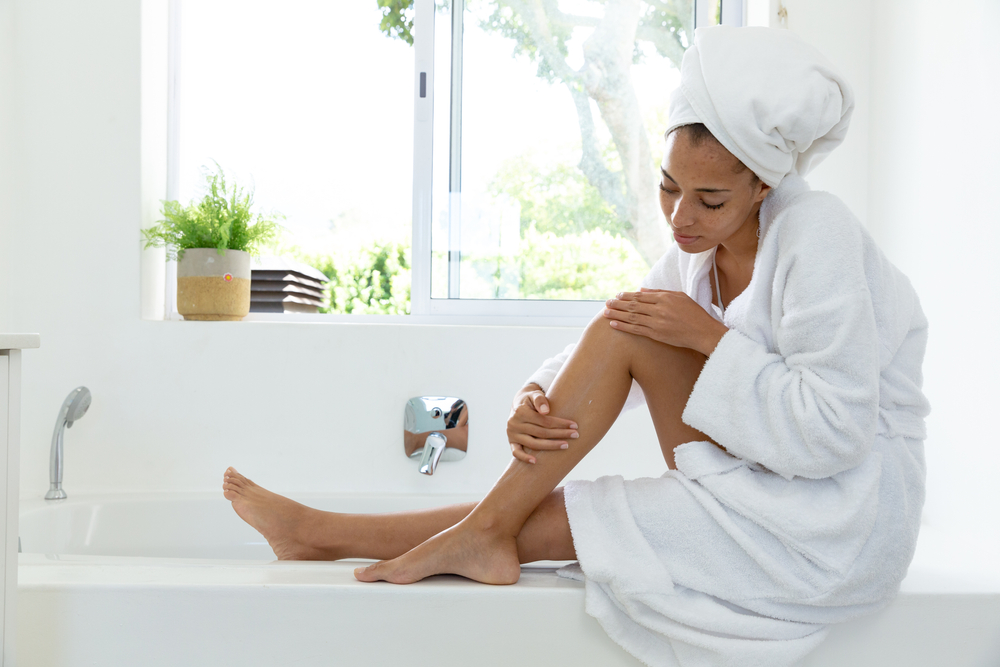
As the heat rises this summer, you may want to spend all your free time cooling off at the swimming pool. Whether you’re diving into the local community pool or floating peacefully in a private home pool, the experts at Florida Dermatology and Skin Cancer Centers (FLDSCC) want you to be sure you’re taking certain precautions to keep your skin free from irritation or infection.
We’ve rounded up the most common skin issues that may be lurking around your swimming pool this summer. Take a look and keep reading for more information, below.
Fungal Infections
- Athlete’s Foot: This fungal infection affects the feet and thrives in warm, moist environments like swimming pool areas. Treatment typically involves antifungal creams or sprays applied directly to the affected area. To prevent athlete’s foot, wear waterproof sandals or shoes in public pool areas, thoroughly dry your feet after swimming, and avoid sharing towels or footwear with others.
- Ringworm: Despite its name, ringworm is not caused by a worm but rather a fungus. It can appear on various parts of the body, including the skin. Antifungal creams or oral medications are commonly used to treat ringworm. Prevention measures include showering after swimming, avoiding sharing personal items like towels or clothing, and wearing clean, dry clothing.
- Nail Fungus: Fungi can infect the toenails or fingernails, causing discoloration, thickening, and brittleness. Treatment options include topical antifungal medications, oral antifungal drugs, or, in severe cases, surgical removal of the affected nail. To prevent nail fungus, avoid walking barefoot in public pool areas, keep your nails clean and dry, and avoid sharing nail clippers or other manicure tools.
- Jock Itch: This fungal infection affects the groin area and is commonly acquired in warm, moist environments like swimming pools. Treatment typically involves antifungal creams or powders applied to the affected area. To prevent jock itch, change out of wet swimsuits promptly after swimming, shower with soap and water, and wear clean, breathable underwear.
In addition to these specific treatments, general prevention measures for fungal infections in swimming pools include practicing good personal hygiene, showering before and after swimming, avoiding sharing personal items, wearing clean and dry clothing, and wearing waterproof footwear in public pool areas. Regular maintenance of swimming pool hygiene, including proper chlorination and filtration, also helps minimize the risk of fungal infections.
Skin Rashes
Swimming pools can cause skin rashes due to various factors, including:
- Chlorine Sensitivity: Chlorine is a strong chemical used to disinfect swimming pools, and its drying properties can strip the skin of its natural oils, leading to irritation. Chlorine can also potentially exacerbate skin conditions such as eczema or psoriasis. For individuals with eczema, chlorine exposure can cause dryness, itching, redness, and flare-ups of eczema symptoms. The harsh effects of chlorine can further compromise the skin barrier, making it more susceptible to irritation and allergens. Similarly, individuals with psoriasis, a chronic autoimmune condition characterized by red, scaly patches on the skin, may experience increased irritation and inflammation from chlorine exposure. The drying effects of chlorine can aggravate psoriasis symptoms and trigger flare-ups in susceptible individuals.
- Bacteria and Microorganisms: Bacteria and microorganisms present in swimming pools can contribute to skin irritation or rashes through various ways. Inadequately chlorinated or poorly maintained pools can become breeding grounds for bacteria, viruses, and other pathogens, increasing the risk of skin infections upon contact with contaminated water. These microorganisms can enter the skin through hair follicles, cuts, or abrasions, leading to conditions such as folliculitis (inflammation of hair follicles), cellulitis (bacterial skin infection), or swimmer’s itch (a skin rash caused by certain parasites).
- Allergic Reactions: Some individuals may be allergic to certain chemicals used in pool maintenance, such as chlorine or bromine, leading to allergic skin reactions. These allergic reactions may vary in severity depending on the person’s sensitivity and the concentration of chlorine or bromine in pool water. To mitigate the risk of allergic skin reactions, those with known sensitivities to chlorine or bromine should consider alternative swimming options, such as saltwater pools or natural bodies of water, and take precautions to minimize exposure to these chemicals.
To help prevent skin rashes from swimming pools, take the following precautions:
- Shower Before and After Swimming: Rinse off before entering the pool to remove sweat, oils, and cosmetics that can react with pool chemicals. Showering after swimming helps remove any residual chlorine or pool water from the skin.
- Use Skin Barrier Protection: Apply a waterproof sunscreen before swimming to create a barrier between your skin and pool chemicals. Consider using a hypoallergenic moisturizer to hydrate and protect your skin.
- Practice Good Hygiene: Wash your hands thoroughly after using the restroom and avoid touching your face or eyes while swimming to prevent the spread of bacteria or viruses.
- Wear Protective Clothing: Consider wearing a rash guard or swim shirt to reduce direct contact between your skin and pool water. Avoid wearing tight-fitting swimwear or clothing that may trap moisture against the skin.
- Choose Well-Maintained Pools: Swim in pools with proper maintenance and regular water quality testing to minimize the risk of bacterial contamination or chemical imbalances.
To treat skin rashes caused by swimming pools:
- Rinse and Cleanse: Rinse your skin with fresh water immediately after swimming to remove any chlorine or pool chemicals. Use a gentle cleanser to wash the affected area and remove any irritants.
- Apply Moisturizer: Use a soothing moisturizer or anti-itch cream to hydrate the skin and alleviate discomfort. Look for products containing ingredients like aloe vera or oatmeal to calm inflammation.
- Seek Medical Advice: If the rash persists or worsens, consult a healthcare professional for proper diagnosis and treatment. They may prescribe topical or oral medications to relieve symptoms and address underlying skin conditions.
By following these preventive measures and promptly treating any skin irritation or rash, you can enjoy swimming in pools while minimizing the risk of skin problems.
Hot Tub Folliculitis
Hot tub folliculitis – also called pseudomonas dermatitis – can develop after you come into contact with bacteria-contaminated water. Hot tub folliculitis is an infection of the hair follicles. It’s caused by the bacteria pseudomonas aeruginosa, which grows in warm, wet, humid areas. Contamination commonly occurs in swimming pools that aren’t maintained at the correct disinfectant level and hot tubs. The rash appears within hours or days after contact with the bacteria; it presents as itchy red bumps spread over the trunk.
Check with officials at your local pool to make sure it’s disinfected at the correct level before you swim in it. Care for a home pool by changing the water regularly, maintaining proper chlorine levels, and continuously filtering pool water to limit the risk of bacterial contamination. If you have a hot tub, don’t overcrowd it with too many people. Hot tub folliculitis typically resolves on its own within one to two weeks.
To care for hot tub folliculitis:
- Keep it Clean: Gently cleanse the affected areas with mild soap and water to remove any bacteria and debris from the hair follicles. Avoid harsh scrubbing, which can exacerbate irritation.
- Apply a Compress: Apply warm compresses to the affected areas for 15-20 minutes several times a day to help soothe itching and inflammation. Be sure the compress is clean to avoid introducing additional bacteria.
- Medications: Over-the-counter anti-itch creams or oral antihistamines can help relieve itching and discomfort associated with hot tub folliculitis.
- Avoid Scratching: Refrain from scratching the affected areas, as this can lead to further irritation, inflammation, and potential scarring.
- Follow Up with Health Care Provider: If symptoms persist or worsen despite treatment, consult your healthcare provider for further evaluation and management.
A Final Reminder
While swimming pools offer refreshing relief during hot summer days, they also present potential risks for various skin issues. From fungal infections like athlete’s foot and ringworm to irritating skin rashes and hot tub folliculitis, it’s essential to remain vigilant about skin health when swimming. Practicing good hygiene, such as showering before and after swimming, wearing protective clothing, and avoiding prolonged exposure to chlorinated water, can help minimize the risk of these common skin problems. If you experience any symptoms of fungal infections, skin rashes, or hot tub folliculitis, seek prompt medical attention from a dermatologist for proper diagnosis and treatment. By prioritizing skin protection and adopting preventive measures, you can enjoy swimming while safeguarding your skin against potential hazards.
Florida Dermatology and Skin Cancer Centers provides a full spectrum of dermatology and skin care services, and its team of physicians, APRNs, and PAs are experts in diagnosing and treating skin cancers, as well as all skin conditions and diseases such as eczema, rosacea, dry skin, rashes, warts and more.
For more information, or to schedule a comprehensive annual skin exam, call (855) FLD-SKIN, or visit www.fldscc.com.


